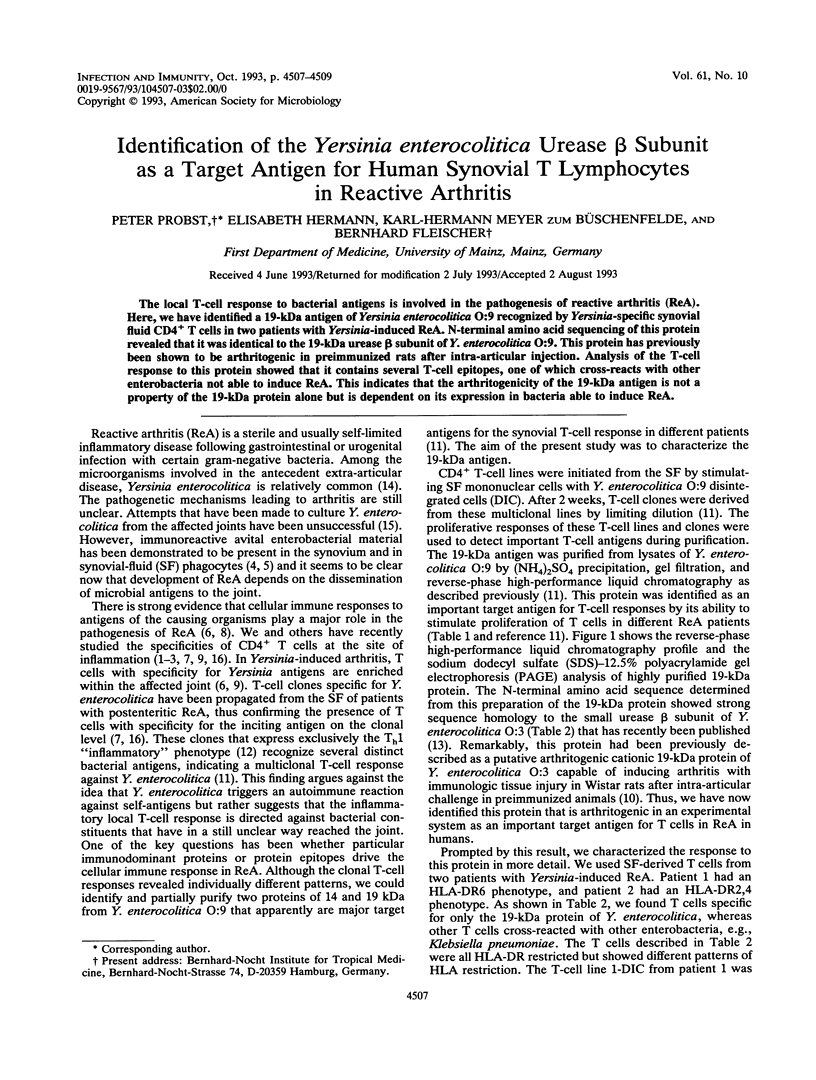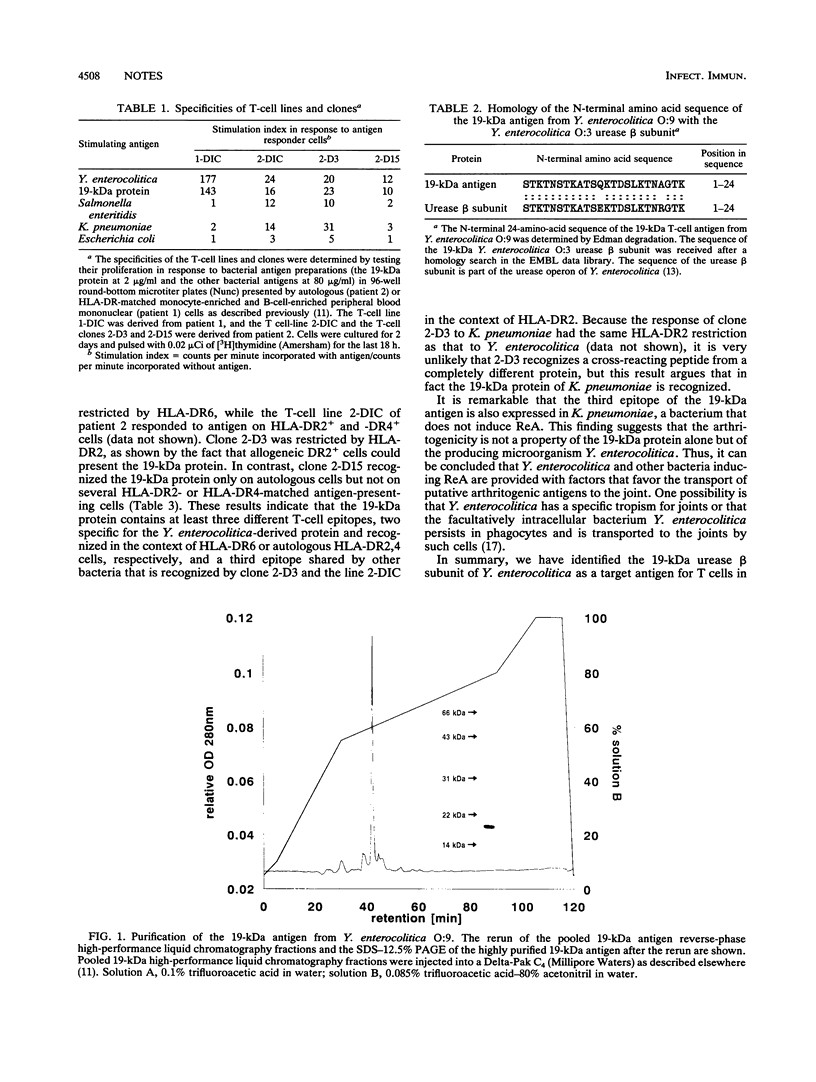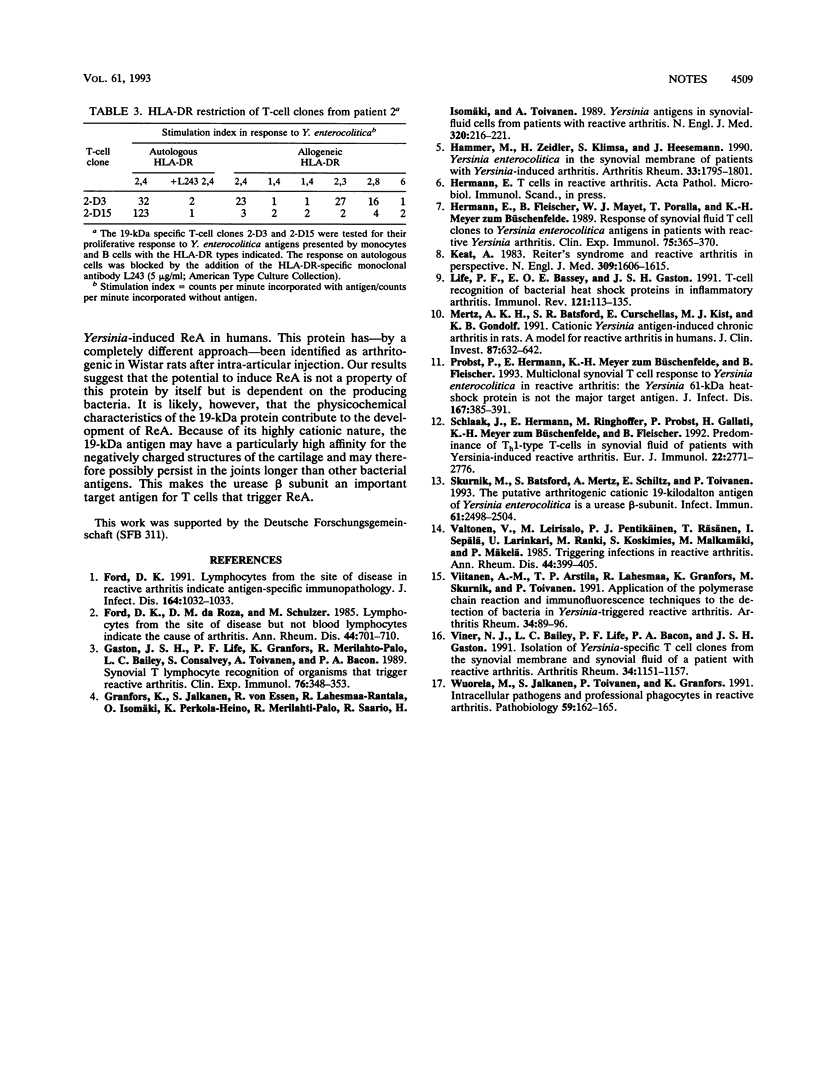Abstract
The local T-cell response to bacterial antigens is involved in the pathogenesis of reactive arthritis (ReA). Here, we have identified a 19-kDa antigen of Yersinia enterocolitica O:9 recognized by Yersinia-specific synovial fluid CD4+ T cells in two patients with Yersinia-induced ReA. N-terminal amino acid sequencing of this protein revealed that it was identical to the 19-kDa urease beta subunit of Y. enterocolitica O:9. This protein has previously been shown to be arthritogenic in preimmunized rats after intra-articular injection. Analysis of the T-cell response to this protein showed that it contains several T-cell epitopes, one of which cross-reacts with other enterobacteria not able to induce ReA. This indicates that the arthritogenicity of the 19-kDa antigen is not a property of the 19-kDa protein alone but is dependent on its expression in bacteria able to induce ReA.
Full text
PDF


Images in this article
Selected References
These references are in PubMed. This may not be the complete list of references from this article.
- Ford D. K. Lymphocytes from the site of disease in reactive arthritis indicate antigen-specific immunopathology. J Infect Dis. 1991 Nov;164(5):1032–1033. doi: 10.1093/infdis/164.5.1032. [DOI] [PubMed] [Google Scholar]
- Ford D. K., da Roza D., Schulzer M. Lymphocytes from the site of disease but not blood lymphocytes indicate the cause of arthritis. Ann Rheum Dis. 1985 Oct;44(10):701–710. doi: 10.1136/ard.44.10.701. [DOI] [PMC free article] [PubMed] [Google Scholar]
- Gaston J. S., Life P. F., Granfors K., Merilahti-Palo R., Bailey L., Consalvey S., Toivanen A., Bacon P. A. Synovial T lymphocyte recognition of organisms that trigger reactive arthritis. Clin Exp Immunol. 1989 Jun;76(3):348–353. [PMC free article] [PubMed] [Google Scholar]
- Granfors K., Jalkanen S., von Essen R., Lahesmaa-Rantala R., Isomäki O., Pekkola-Heino K., Merilahti-Palo R., Saario R., Isomäki H., Toivanen A. Yersinia antigens in synovial-fluid cells from patients with reactive arthritis. N Engl J Med. 1989 Jan 26;320(4):216–221. doi: 10.1056/NEJM198901263200404. [DOI] [PubMed] [Google Scholar]
- Hammer M., Zeidler H., Klimsa S., Heesemann J. Yersinia enterocolitica in the synovial membrane of patients with Yersinia-induced arthritis. Arthritis Rheum. 1990 Dec;33(12):1795–1800. doi: 10.1002/art.1780331206. [DOI] [PubMed] [Google Scholar]
- Hermann E., Fleischer B., Mayet W. J., Poralla T., Meyer zum Büschenfelde K. H. Response of synovial fluid T cell clones to Yersinia enterocolitica antigens in patients with reactive Yersinia arthritis. Clin Exp Immunol. 1989 Mar;75(3):365–370. [PMC free article] [PubMed] [Google Scholar]
- Keat A. Reiter's syndrome and reactive arthritis in perspective. N Engl J Med. 1983 Dec 29;309(26):1606–1615. doi: 10.1056/NEJM198312293092604. [DOI] [PubMed] [Google Scholar]
- Life P. F., Bassey E. O., Gaston J. S. T-cell recognition of bacterial heat-shock proteins in inflammatory arthritis. Immunol Rev. 1991 Jun;121:113–135. doi: 10.1111/j.1600-065x.1991.tb00825.x. [DOI] [PubMed] [Google Scholar]
- Mertz A. K., Batsford S. R., Curschellas E., Kist M. J., Gondolf K. B. Cationic Yersinia antigen-induced chronic allergic arthritis in rats. A model for reactive arthritis in humans. J Clin Invest. 1991 Aug;88(2):632–642. doi: 10.1172/JCI115348. [DOI] [PMC free article] [PubMed] [Google Scholar]
- Probst P., Hermann E., Meyer zum Büschenfelde K. H., Fleischer B. Multiclonal synovial T cell response to Yersinia enterocolitica in reactive arthritis: the Yersinia 61-kDa heat-shock protein is not the major target antigen. J Infect Dis. 1993 Feb;167(2):385–391. doi: 10.1093/infdis/167.2.385. [DOI] [PubMed] [Google Scholar]
- Schlaak J., Hermann E., Ringhoffer M., Probst P., Gallati H., Meyer zum Büschenfelde K. H., Fleischer B. Predominance of Th1-type T cells in synovial fluid of patients with Yersinia-induced reactive arthritis. Eur J Immunol. 1992 Nov;22(11):2771–2776. doi: 10.1002/eji.1830221103. [DOI] [PubMed] [Google Scholar]
- Skurnik M., Batsford S., Mertz A., Schiltz E., Toivanen P. The putative arthritogenic cationic 19-kilodalton antigen of Yersinia enterocolitica is a urease beta-subunit. Infect Immun. 1993 Jun;61(6):2498–2504. doi: 10.1128/iai.61.6.2498-2504.1993. [DOI] [PMC free article] [PubMed] [Google Scholar]
- Valtonen V. V., Leirisalo M., Pentikäinen P. J., Räsänen T., Seppälä I., Larinkari U., Ranki M., Koskimies S., Malkamäki M., Mäkelä P. H. Triggering infections in reactive arthritis. Ann Rheum Dis. 1985 Jun;44(6):399–405. doi: 10.1136/ard.44.6.399. [DOI] [PMC free article] [PubMed] [Google Scholar]
- Viitanen A. M., Arstila T. P., Lahesmaa R., Granfors K., Skurnik M., Toivanen P. Application of the polymerase chain reaction and immunofluorescence techniques to the detection of bacteria in Yersinia-triggered reactive arthritis. Arthritis Rheum. 1991 Jan;34(1):89–96. doi: 10.1002/art.1780340114. [DOI] [PubMed] [Google Scholar]
- Viner N. J., Bailey L. C., Life P. F., Bacon P. A., Gaston J. S. Isolation of Yersinia-specific T cell clones from the synovial membrane and synovial fluid of a patient with reactive arthritis. Arthritis Rheum. 1991 Sep;34(9):1151–1157. doi: 10.1002/art.1780340911. [DOI] [PubMed] [Google Scholar]
- Wuorela M., Jalkanen S., Toivanen P., Granfors K. Intracellular pathogens and professional phagocytes in reactive arthritis. Pathobiology. 1991;59(3):162–165. doi: 10.1159/000163636. [DOI] [PubMed] [Google Scholar]



